In brief: The Silla Kingdom of south-central Korea endured for nearly 900 years until 935. Today its legacy comes alive in its former capital, Gyeongju.
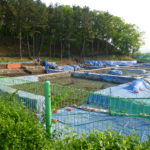
It’s thrilling to discover a history completely unknown to us. The Silla Kingdom of south-central Korea endured for nearly 900 years until 935, with its capital located in Gyeongju, now a UNESCO World Heritage site. The kingdom proved strong militarily, as even then the north and south Korean kingdoms kept confronting each other. But Silla kings were also deft at diplomacy when needed and capable of managing their lands to produce wealth. Most of Silla’s palaces, temples and treasures disappeared completely, finished off during the destructive Japanese invasion of the 16th century – and then superseded by a long-lasting new dynasty, the Joseon.

Modern day Koreans enjoy celebrating that Silla period by dressing up in aristocratic costume for a day out with a partner or with the family.

What is known of the lifestyle comes mainly from artifacts found deep within the mounds where its kings and queens were buried, tumuli we saw spread all around Gyeongju. Many of the tumuli are obvious, isolated in parks within the city, but some are just being re-discovered because they look like natural hilly features decked with trees.
The graves consisted of stone layers and timber structures formed into a mound, and filled with thousands of items to accompany the dead on their passage. Earth and stone were added on top to enlarge the mound. The design helped ensure that the graves would not be robbed as the heavy stuff would collapse on the valuable things. Mounds of a royal couple often were connected in death, as in life.
Some examples from the wonderful archeological museum here:
-
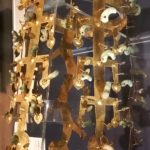
Silla gold crown A gold crown for a Silla king. The drapery represents a kind of tree, with leaves of gold and fruit of jade, and so was said to deliver prosperity and longevity for the kingdom.
-
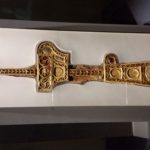
Sword sheath, Gyeongju A sword sheath worthy of display on ritual occasions: its source was really outside Korea, but demonstrates how connected the Silla Kingdom was with the outside world via the Silk Road. During that time, however, the biggest threats were on the peninsula.
-

Fanciful clay pot A Silla clay pot with simple decoration except for these odd, fanciful and sexually active figures around the neck.
-
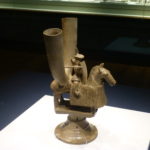
Silla drinking cup A delightful drinking cup in the form of a rider on horseback. We quickly passed this by, but were drawn back by the whimsy and charm.
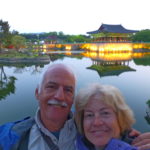
Graves were not the only source of valuable findings over the years. Over 1200 years ago, the wondrous, sprawling Donggung Palace, along one side of the man-made Wolji Pond, helped the rulers of the kingdom relax. After hundreds of years of use, it too fell into ruin. In the pond and under the remains, archeologists unearthed diverse objects – from canoes to tools to bones.

The most interesting, to us, were wood memo pads used by Silla administrators. With them, they could do inventory, keep records and so on. They could even reuse the sticks by sanding the surface to a blank.
Three of Donggung’s main buildings have been re-built around the pond, restored to its former shape, they say. Splendidly lit at night, the site attracts families, romantic couples and busloads of visitors to enjoy the spectacle.
Fervent religious practice, we found, was a binding force that helped hold the medieval Silla kingdom together for those 900 years. The tombs, and the associated rituals, demonstrate a strong belief in a continuation of life after death though, in their class-driven society, the wealthy rulers earned the best send-offs.
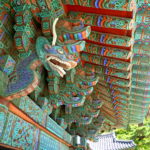
At first, its religion was principally shamanic and animistic until the adoption of Buddhism in the 7th century. Today 45% of Koreans are still Buddhist, while nearly 55% practice Christian faiths imported by missionaries – with a dollop of shamanism as well.
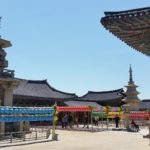
For the next 300 years of the Silla kingdom, and during subsequent Korean dynasties, the wealthy funded magnificent Buddhist temples like Bulguksa in Gyeongju. Bulguksa’s stone foundations have stood for 1500 years. One reason for that is their architectural ingenuity. The builders solved the problem of building on uneven ground.
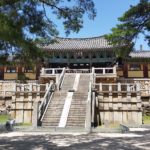
And the elegant two level staircase, supported by an arch, is as much a bridge as a stair, and carries symbolic significance – representing movement between earthly and heavenly realms, as well as between youth (the lower blue cloud bridge) and age (the upper white cloud bridge).

In the temple’s main courtyard, original stone pillars still stand, revered in themselves for holding sacred remnants and texts.
Back in the Gyeongju National Museum, several rooms displayed many Silla images of Buddha, found across the region, including a striking cast bronze, larger than life medicine-master from the late 8th century.
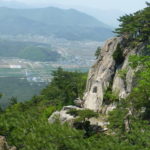
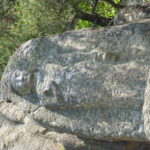
The Silla supplanted nature worship even in the woods, with masterfully carved statues and etched rock faces all over sacred mountains like Namsan.
These include a massive relief of a Maae Buddha visible from the town it gazes upon and a Boddhisatva, attendant to Buddha, that appeared to offer a Mona Lisa smile that changes with the light.

Near Bulguksa temple, at Seokguram grotto, was one of the most sublime of the religious creations, an artistic and engineering triumph. Carved from a single granite rock and flanked by guardians and attendants, it smiles beatifically in celebration of enlightenment. We reached it by climbing some 400 meters in altitude (though most ride vehicles to the top along the wayward road).
Whether we were climbing or museum-going, over and over again the town of Gyeongju – the capital of the Silla kingdom – opened an historical window for us that had previously been unknown and dark.
(Also, for more pictures from Korea, CLICK HERE to view the slideshow at the end of the itinerary page.)






